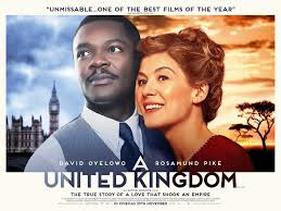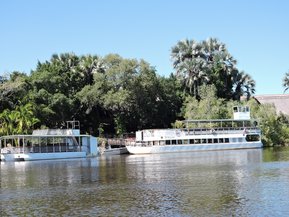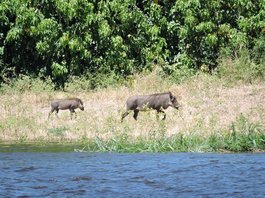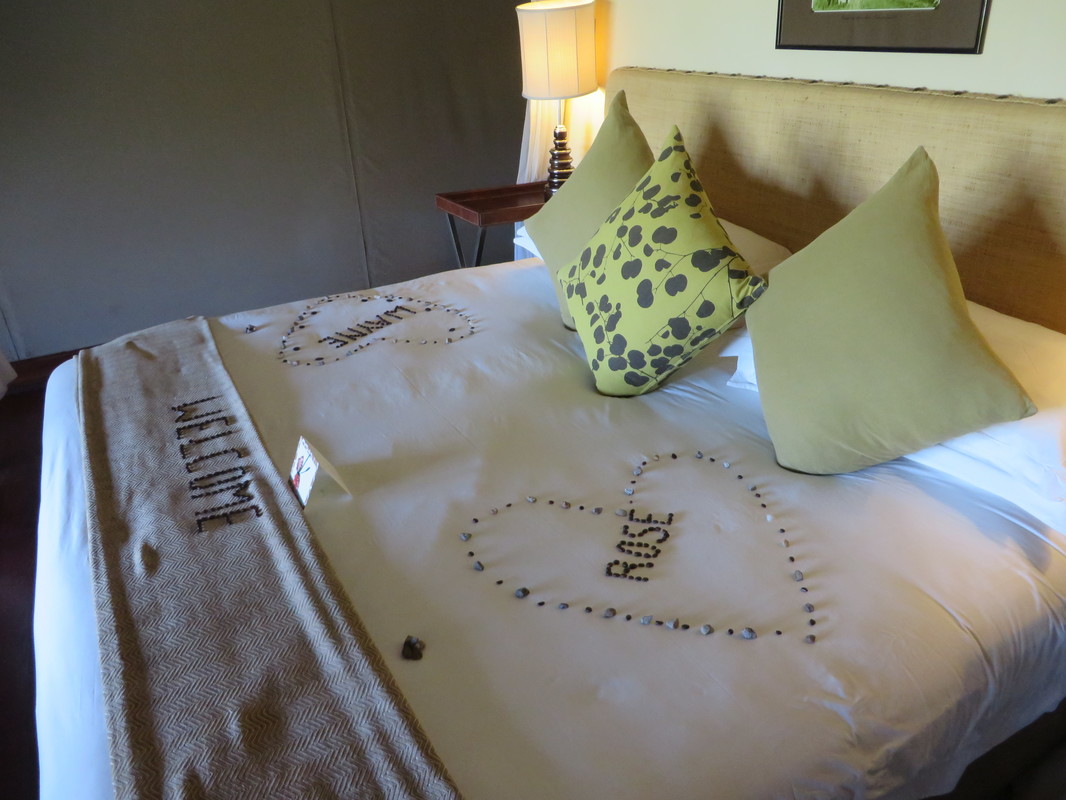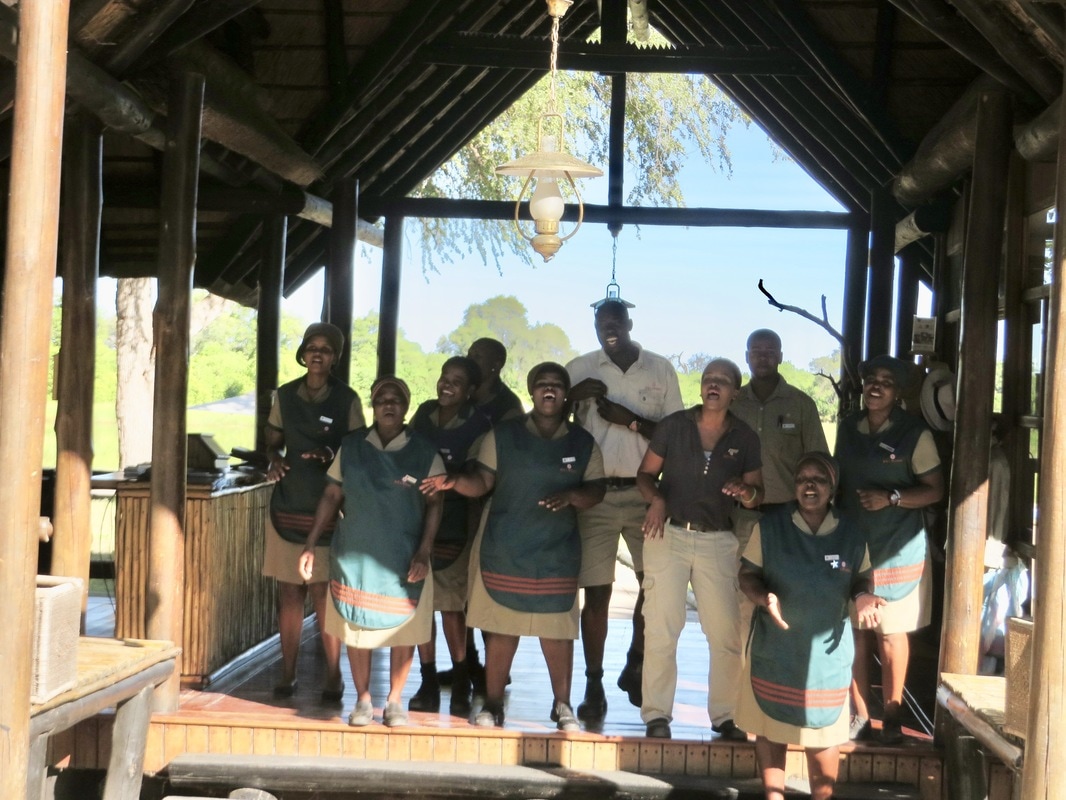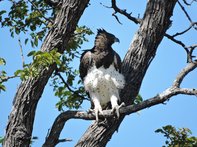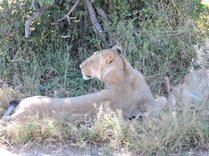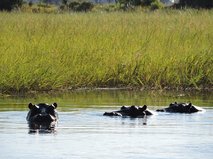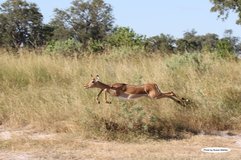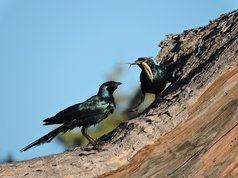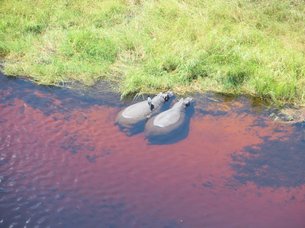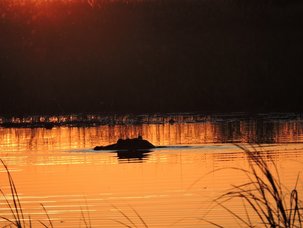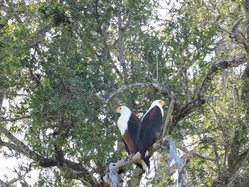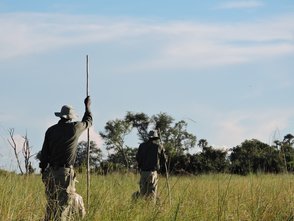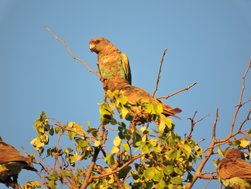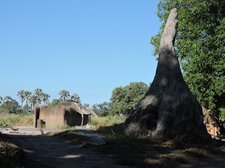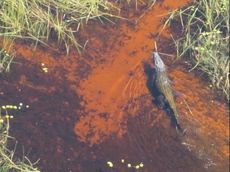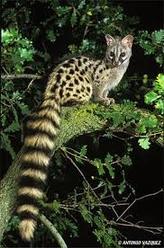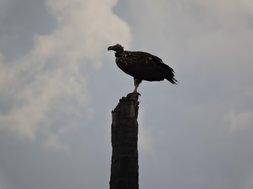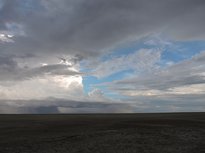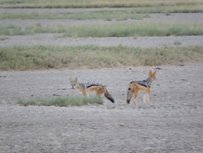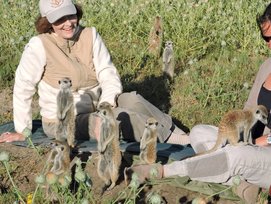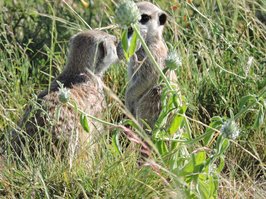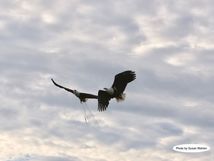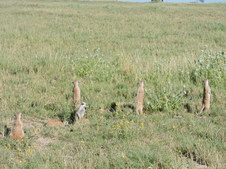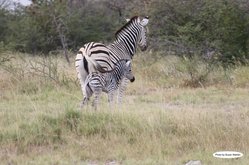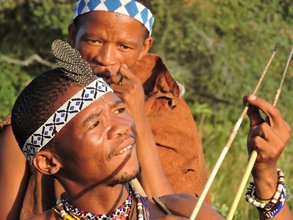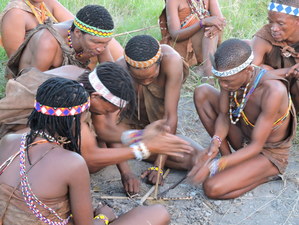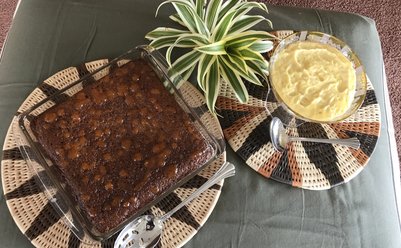After ferrying across the Zambezi river from Zambia to Botswana, we were met at the border check station by Fuzzy, the ivory sniffing Cocker Spaniel, trained to detect illegal ivory in people’s luggage. This was our first indication that Botswana is serious about protecting its elephant population. Indeed, Botswana has the largest African elephant population on earth, with at least 50,000 elephants living along the Chobe River in the dry season and many more in other areas of the country, including the Okavango Delta. Elephants in Botswana receive military protection, and poaching is not tolerated. We were pleased to learn that Botswana is a safe and well-managed democracy, providing education and health care for all its citizens. Botswana is listed as the least corrupt country in Africa by the watchdog group, Transparency International. The diamonds that were discovered in Botswana in 1970 are mined and managed by public-private partnerships in which the government holds equity positions.
The history and culture of Botswana have become better known to non-Africans through popular media, notably the film United Kingdom and the No. 1 Ladies’ Detective Agency series of detective novels by Alexander McCall Smith. United Kingdom, starring two very handsome British actors, David Oyelowo (who portrayed Martin Luther King, Jr. in the film Selma,) and Rosamund Pike (Gone Girl,) chronicles the courtship and marriage of Botswana’s young king, Seretse Khama to a British woman, Ruth Williams. Their inter-racial marriage caused outrage in neighboring South Africa, which had established a policy of apartheid, or racial separation. At that time, Botswana (then called Bechuanaland,) was a British protectorate, and the degree to which the British government, based almost entirely on racism, persecuted and manipulated Seretse and Ruth, is shockingly portrayed in the film. The happy conclusion to this story is the fact that Seretse and Ruth ultimately returned to his homeland, where he helped to transform Bechuanaland from a kingdom and British protectorate into a Democracy, and in 1966 was elected the first President of Botswana. A bit ironically, Seretse was also knighted in 1966 by Queen Elizabeth II. Sir Seretse died in 1980, and in 2009, his and Ruth’s son Ian was elected President in a landslide.
The seventeen No. 1 Ladies’ Detective Agency novels, which have sold more than twenty million copies in English and have been translated into forty languages, provide a charming insight into the lives and values of the people of Botswana through the adventures of the heroine, Precious Ramotswe. Mma. Ramotswe is a compassionate, attractive, wise and very smart woman whom it is impossible to dislike. She solves mysteries by sitting in the shade under a tree, thinking and drinking bush (Rooibos) tea in front of her agency in Gaborone, Botswana’s capital. Readers also learn to love Precious’ gentleman admirer, Mr. JLB Matekoni, proprietor of the Tlokweng Road Speedy Motors Garage (the best auto mechanic in Botswana) and Precious’ energetic secretary, Grace Makutsi. People who like television more than books can meet all of these delightful characters and more in the 2008 BBC production which is now available from HBO Go. Sadly, the series lasted for only a year, but it is addictively decent and genuinely entertaining. Our friend, David Oyelowo, (Seretse Khama of United Kingdom) even appears in one of the episodes. The American blues singer and actress, Jill Scott, shines as Precious Ramotswe, and Lucian Msamati is perfection as Mr. JLB Matekoni. I must give a shout out to my cousin, Marny Pickett, who told me all about the No. 1 Ladies’ Detective Agency novels when I emailed her that I was preparing to go to Botswana. I was grateful that I had the time to read the first two novels and watch the entire television series before leaving on my journey. When I arrived in this friendly and peaceful country, I immediately felt right at home.
Our time in Botswana was focused on experiencing the people and the wildlife in three specific areas: the Moremi Game Reserve on the Khwai River, the Eagle Island Camp on the Okavango Delta and the Makgadikgadi Pans National Park near the Khalahari Desert. Each area had its own unique human culture, wildlife and ecosystem. Our first adventure in Botswana was a riverboat safari which included lunch on the Chobe River. It was here, as we floated along admiring the elephants feasting on the long grasses in the river among the water lilies, that I had my first bite of Malva Pudding.
The woman who had prepared our lunch at a nearby lodge joined us on the boat to make sure the buffet was in order. After a tasty and healthy meal of baked river fish and steamed vegetables, I approached the dessert table and noticed a rather plain looking dark brown single-layer cake which no one had yet tried. I asked the cook what it was, and she said, “Malva Pudding.” I had never heard of this dessert and asked her what was in it. Her reply startled me, “Apricot jam.” Intrigued, I tried a slice, with pourable custard sauce (crème Anglaise in France) from a pitcher placed immediately in front of the cake. It was divine in a subtle, moist, and surprising way, and it was love at first bite. Fortunately, I had the opportunity to taste Malva Pudding on two future occasions before returning home from Africa, and I learned that it is southern Africa’s most popular dessert. At the end of this blog, you will find the recipe for Malva Pudding, which I made to add to the Easter dessert table immediately after our return home.
After our brief sojourn on the Chobe, we flew to Khwai, where we discovered that the airstrip at our next destination, the Khwai River Lodge at the Moremi Game Preserve, was flooded due to excessive rain. Our resourceful Tour Director, Susan Wahlen, had already arranged for us to fly to the camp by helicopter. It was thrilling to look out of the copter at elephants, not far below us, feeding with their babies in peaceful family groups. The lodge turned out to be a lovely place, with separate “cabins,” actually very comfortable lodgings right on the river. In a charming touch, our names were written on our bed with small river pebbles and encircled in a heart that read, “Welcome.” On our arrival at the lodge, we were greeted by the entire staff who sang, “Dumela,” which means, “hello and welcome,” in a rousing traditional African style call and response lead by a soprano with the other women and the men as her booming backup singers. They also sang the lyrical “Beautiful Botswana,” in the same antiphonal style. After the songs, every member of the staff shook hands with every guest and introduced him or herself, and we introduced ourselves as well. I felt as though we were long lost family members, and they were offering us enthusiastic and heart-felt hospitality.
As it turned out, we also arrived just in time for Afternoon Tea, which the chef had elegantly laid out in the community meeting area. We were treated to savory Sage Scones with grated cheddar cheese and unsweetened whipped cream, vegetable and mozzarella kabobs, apple pie pastries, and iced Rooibos tea. The British influence from the old protectorate days is still evident in the Afternoon Tea custom, celebrated throughout the country, as well as the decorous politeness, which may have been part of the culture before anyone from England ever arrived. In any case, the people of Botswana seem to have preserved the best of their former “protector’s” culture while eliminating the worst. Imagine Britain with all its quaint traditionalism and homey charm, without a whiff of class consciousness, snobbery or racism. Surprise! You’re in Botswana!
We climbed into our open-sided safari vehicles for our afternoon into evening game viewing drive. Our driver and expert safari guide was a young man named Goms, who turned out to be very proactive and passionate about finding as many animals as possible and was willing to drive our fancy new vehicle off road and even through lakes to find the closest view. He also exhibited an encyclopedic knowledge of every species in the park. Just a sampling of the animals we saw included elephants, zebras, impalas, mongoose, warthogs, big cats and many gorgeous birds.
Sunsets in Africa last for a long time; it was glorious to watch the deep pink glow filling the night sky along with the sound of the river and the evening insects.
The next morning, we were off on another game drive, and this time we saw the lions who were sleeping yesterday afternoon, wide awake and ready to hunt. There were two females, working together, watching a herd of impalas and a nearby group of zebras. Stealthy and quiet, the lions crouched in the grasses, patiently waiting for their opportunity. Lions are not fast runners, and they need to attack from a very short distance. As a result, they often wait for long periods of time for their prey to move close enough for them to make their kill. I was relieved that we chose not to spend the entire morning waiting to see a lion kill an impala or a zebra.
Lunch back at the lodge included locally grown beets served as a salad with feta cheese, white asparagus with sweet pickles and red peppers and a nice vegetable casserole with yellow squash. Dessert was squares of pineapple cake that looked exactly like American cornbread. We left this lovely lodge on the Khwai River and boarded our helicopters for our next destination, the Eagle Island Lodge on the Okavango Delta. As we were waiting to board the copters, two elephants came out of the foliage across the river, and we could see them browsing, flapping their ears, and facing us across the water. Looking down from the helicopter, we saw another elephant and two hippos in a pond. The helicopter afforded us a stunning view of the entire landscape, a vast flat terrain of mopane and acacia trees and wild sage bushes dotted with little pools and lakes created by the recent unexpectedly heavy rain. This unchanging landscape stretched all the way in every direction to the round horizon, with no variation, no hills.
Our short flight took us to another world. The Okavango Delta is a lush, watery habitat fed by waters that move slowly south from Angola in the rainy season. This is a place where elephants, hippos, crocodiles and thousands of beautiful water birds, including the African Fish Eagle, thrive. After a familiar and comforting Afternoon Tea, we boarded a barge for close-up views of hippos, cormorants, herons, pygmy geese and the glorious malachite kingfisher, a small, brilliantly colored bird that perches in tall grasses, right on the water’s edge.
The sun set while we were returning to the lodge, and a luminous red glow covered the water and the entire horizon, creating stark silhouettes of the dark, bushy trees. Hundreds of dragon flies came out to feast on smaller insects right in front of our barge, just as the sun went down.
Our time on the Delta included an early morning motor boat ride through the watery grasses among the hippos and crocodiles and another helicopter sightseeing ride, one of the highlights of our trip to Botswana. From the copter, from which the doors had been removed, we could view the entire landscape, populated with large numbers of land animals as well as aquatic. Botswana’s well-protected elephants, large herds of mothers and babies, were everywhere, as were many pods of hippos, family groups of giraffes, warthogs, baboons, wildebeest, zebras, antelope, saddle-billed storks and fish eagles and a large crocodile, swimming down a narrow channel. It was exhilarating to see so many healthy animals in their family units in a safe natural environment where they had generous amounts of space to thrive and reproduce.
Our final adventure at the Eagle Island Lodge took us from the wide lens view of the helicopter to the microscopic perspective of a makoro. A makoro is a traditional dugout canoe that can carry two seated passengers with a man standing in the back wielding a long pole to push the boat through the shallow water and dense vegetation. A makoro not only provides transportation from one village to the next; it also allows for very close viewing of small animals, birds and insects that live among the aquatic plants near the water’s surface. We saw tiny painted reed frogs and long reed frogs, clinging to the plants right next to our canoe. We also spotted a red eyed dove and a woodland kingfisher. And as our little boat glided past a thorn tree, we saw that it was filled with gorgeous green parrots.
During our leisurely float through the water world, our boatman, who introduced himself as Jimmy along with the customary handshakes and introductions on our part, explained in exact and scientific detail how the villagers in the surrounding area harvest large numbers of termites, cook, prepare and powder them to obtain a year’s supply of edible protein.
We left the Okavango Delta, flying for about an hour in a small plane, to the third ecosystem we planned to visit, the Makgadikgadi Pans National Park near the Kalahari Desert. This large area of salt pans, surrounded by dry savanna, was once covered by a salty lake that dried up thousands of years ago. Now it is home to hardy plants, animals and birds, as well as ancient tribal people who have learned to survive in this harsh landscape through adaptation and resourcefulness.
Upon our arrival at Camp Kalahari, we were greeted by our three local guides, Bart, Bones and Jonas, who along with the rest of the staff, welcomed us with the now familiar handshakes and introductions all around. Our “tent” in this camp was elevated on a high platform with a wooden stairway leading up. There were canvas walls with zippers separating the bathroom area from the very comfortable sleeping room. We learned the importance of these zippers on our final morning in the camp when we carelessly left a zipper undone and a genet, escaping the chilly pre-dawn, sneaked in and jumped onto Wayne’s lap during our morning meditation. I don’t think Wayne had ever been so startled, but he did admit that the uninvited genet had very soft fur, like an oversized and very fluffy house cat.
Another pleasant surprise was the quality of the food at Camp Kalahari, where the chef makes her own chili sauce with local red and green peppers, and even bakes homemade crackers. Our first lunch was an elegant salade nicoise with fresh rosemary focaccia. For dessert, we enjoyed pears and grapes with very good cheeses, brie and bleu. We could almost have been in another dry landscape—the south of France. Throughout southern Africa we noticed an appreciation of European cuisine as well as local game and African style vegetable stews.
On our afternoon game drive with Bart, a Belgian who seems to have lived in the Makgadikgadi Pans for many years, we were surprised by a sudden downpour of rain with thunder and lightning.
I was intrigued by this desert landscape of salt pans, occasional little lakes and water holes, thorny acacia trees, thin tall palms and wildflowers. We saw an amazing amount of wildlife in this seemingly harsh environment, including ostriches, vultures, zebras, wildebeest, rare red hartebeest and springbok. As we drove along, the sky darkened and became hauntingly beautiful. We saw both a rainstorm and a sandstorm next to each other on the horizon. The thunder and lightning continued into the night.
A high point of our time in the Makgadikgadi Pans was our morning visit with the meerkats. We had to rise very early to position ourselves on the dry and chilly ground near the holes leading to the subterranean tunnels that these little carnivores share with vegetarian ground squirrels and snake eating mongoose in a sort of underground inter-species apartment building. We learned that near a remote village there were several families of meerkats who had become accustomed to human beings wandering through their habitat. These are not tame animals, nor are they in captivity. They are completely wild, but as we learned, they will initiate interactions with humans if they feel so inclined, though we were strictly forbidden from touching them. We hoped they would interact with us as we waited for them to wake up and come out of their holes to greet the day. Our patience was rewarded.
I was thrilled when the first meerkat came out of the hole right where I was sitting. Then, one at a time, all nine members of the family emerged, including the pregnant alpha female and four youngsters. I was sitting with Susan, our Tour Director, and the meerkat family stayed right around us for some time, standing up and looking around, soaking up the sunshine, chattering and even climbing up on Susan’s legs. Eventually they moved on into their morning routine. The youngsters played by running and jumping on each other, and after a brief play time, the adults began searching for food. The entire family spread out together, each youngster accompanied by an adult who was teaching him how to dig for beetles, grubs and small frogs. The adults shared the food they found with the babies. One youngster actually caught a frog on his own, and his patient mentor stood beside him as he ate it to make sure no one else from the family snatched the frog away from the little one.
Soon enough, the meerkats’ arch enemy, an eagle, appeared, circling overhead. All of the adult meerkats stood at attention while the young hid in the brownish grasses, the same color as their fur. They were prepared to scamper back down their holes, which dotted the landscape as their escape routes, but fortunately for this family, the eagle flew off elsewhere.
On our way back to the camp, Jonas, our guide, pointed out a large flock of about seventeen ostriches, black males and brown females, flapping their wings and “dancing” around to get rid of parasites. We also saw a large herd of zebras, several wildebeest, bustards, quail, lapwings and even some wild melons growing on the ground, having been planted by elephant droppings.
Our time in Botswana, one of the most charming places I have ever visited, concluded with a late afternoon desert field trip accompanied by a group of local San Bushmen. Their ancestors, among Africa’s first human residents, lived in the area as long ago as 200,000 years and survived in the Kalahari as hunter-gatherers. If possible, this extended family was even friendlier than the many other friendly and interesting people we had met in Botswana. This cheerful and fun loving group arrived in their traditional attire, animal skins tied around their bodies, hand-made sandals and beaded headdresses, necklaces and bracelets. The multi-generational family included infants carried by their mothers, grandmas and various adults, both male and female. There were greetings, introductions and handshakes among all of us. Then this energetic group lead us on a walking tour in the desert to demonstrate to us first-hand the ancient hunter-gatherer lifestyle of their ancestors.
As we wandered through the desert, various members of the family showed us how to dig up tubers and bulbs that could be used as medicine or to provide drinking water during the dry season. They also showed us how to trap a bustard on the ground and how to use an egg to lure and catch an adult bird. Famous for their use of poisoned arrows to hunt kudu and springbok, they brought their arrows along and pointed out where they obtained the poison from caterpillars that live in a specific tree. We observed the San to be very chatty and sociable. They kept up a running conversation in their melodic language, filled with the famous clicking sounds, and some of them spoke to us in English. There appeared to be no specific leader in the group, and the women were clearly as important to the family as the men.
The group stopped at various points in our field trip just to entertain themselves and us and have a little fun. One young man insisted on digging up a scorpion from its hole in the ground and putting the scorpion in his mouth. Then he put the scorpion back in its hole unharmed. It was admirable and remarkable how small a footprint the San people left on the landscape. Every time they dug up a root or tuber to show us, they placed it back in the ground and covered it up again with dirt so it could continue to grow. Two men and a woman demonstrated how to make a fire by rubbing dried branches together, and after the fire had started, the entire family sat down around the campfire, sang and played a game similar to “Rock, Paper, Scissors,” leaning over the fire, laughing and responding to each other’s gestures and body language. The closest translation we could get to the name of this game was “Lightning and Springbok.” They got up and all started dancing just as the sun went down.
Our time in beautiful Botswana had come to an end, and the next morning, after Wayne’s encounter with the genet in our tent, the guides at our camp told us that the animals were responding to the coming of winter with its chilly nights. They said they heard jackals yelping during the night, and both a male and a female lion, roaring.
Malva Pudding
Malva Pudding is a popular dessert throughout the countries of southern Africa, although food historians say it is of Cape Dutch origin, and thus South African. However, we were served Malva Pudding on three different occasions during our African adventure, and the first time was in Botswana. Malva Pudding is one of those magical desserts, like Tres Leches Cake from Spain and Mexico, that is deceptively simple yet apparently complex and mysterious. It does not readily reveal its ingredients and simply looks like a dense, moist, plain looking brown cake. The woman who baked the Malva Pudding that we ate in Botswana revealed to me that the secret ingredient was apricot jam. Yes, Malva Pudding does contain apricot jam, but there is more to the story than that. For one thing, the pudding is infused with a syrup which contains Rooibos Tea, also called Bush Tea, a popular beverage in Botswana. And finally, Malva Pudding should always be served with homemade custard, preferably still warm.
For the Pudding:
- 1 cup milk, at room temperature (not low fat)
- 1 teaspoon baking soda
- 1 cup flour
- ¾ cup brown sugar
- ¼ teaspoon salt
- 1 teaspoon baking powder
- 1 large egg, at room temperature
- 1 tablespoon vinegar
- 2 tablespoons apricot jam, plus 2-4 tablespoons more for glazing the cake
- cooking spray
For the Syrup:
- 1 cup granulated sugar
- 1 cup milk (not low fat)
- ½ cup boiling water or hot brewed Rooibos tea
- ¼ cup (half a stick) butter, at room temperature
- 1 teaspoon vanilla extract
For the Homemade Custard:
- 6 large egg yolks
- 1 cup sugar
- 2 cups very hot milk or half and half (not low fat)
- ½ cup flour
- 2 tablespoons butter
- 2 teaspoons vanilla extract
Special equipment: electric mixer, 2 medium sized mixing bowls, sieve or flour sifter, 2-cup glass measure, 8” square glass baking pan, rubber spatula, bamboo skewer, 4-cup glass measure, wire rack, medium sized cooking pot, immersion blender, plastic wrap
Preheat oven to 350°F
Makes: approximately 8 servings
- Make the pudding: Spray an 8” square glass baking pan with cooking spray and set aside. Combine the milk and baking soda in a 2-cup glass measure and set aside. In a medium sized mixing bowl, sift together the flour, salt and baking powder.
- In another medium sized bowl, with an electric mixer, beat the brown sugar and egg together until fluffy. Add the vinegar and 2 tablespoons apricot jam and mix well. Add the flour mixture and milk mixture alternately until well combined. Scrape the batter into the prepared pan and smooth the top with a rubber spatula.
- Bake for 30 minutes or until a bamboo skewer inserted in the center comes out clean.
- While the cake bakes, prepare the syrup: Combine all the syrup ingredients in a 4-cup glass measure and stir to dissolve the sugar. Microwave the mixture at 30 second intervals, stirring in between, until the syrup starts to boil. Remove from the microwave before the syrup boils over.
- Place the baked cake on a wire rack and poke the hot cake all over with the bamboo skewer. Slowly pour the hot syrup over the entire cake. It will absorb all the liquid. When the pudding has cooled slightly, microwave 2-4 tablespoons of apricot jam and pour it carefully, a few drops at a time, over the pudding as a glaze. Serve the pudding warm with warm custard, or refrigerate overnight and bring it to room temperature before serving.
- Make the custard: Pour 2 cups of milk or half and half into a 4-cup glass measure and heat in the microwave until it just starts to boil. Set aside. Place the egg yolks and sugar in a medium sized mixing bowl and beat with an electric mixer until the mixture turns a pale yellow and forms a slowly falling ribbon when the beaters are lifted, about 4-6 minutes.
- Add the flour and mix well. Slowly add the hot milk and continue beating on low speed, scraping the side of the bowl with a rubber spatula, until the mixture is smooth. Transfer the custard batter into a medium sized cooking pot and cook on medium heat, stirring continuously, until the mixture starts to boil. (I use an immersion blender to prevent the custard from sticking to the bottom of the pan and burning.)
- Lower the heat and continue cooking and whisking for a few more minutes until the custard is boiling and very thick. Remove from the heat and stir in the butter and vanilla until the mixture is well blended and the butter has melted. Place a sheet of plastic wrap directly on the custard to prevent a skin from forming. If serving immediately, transfer the custard to a decorative bowl with a serving spoon and serve with the Malva Pudding. Custard can also be refrigerated and served cold.
